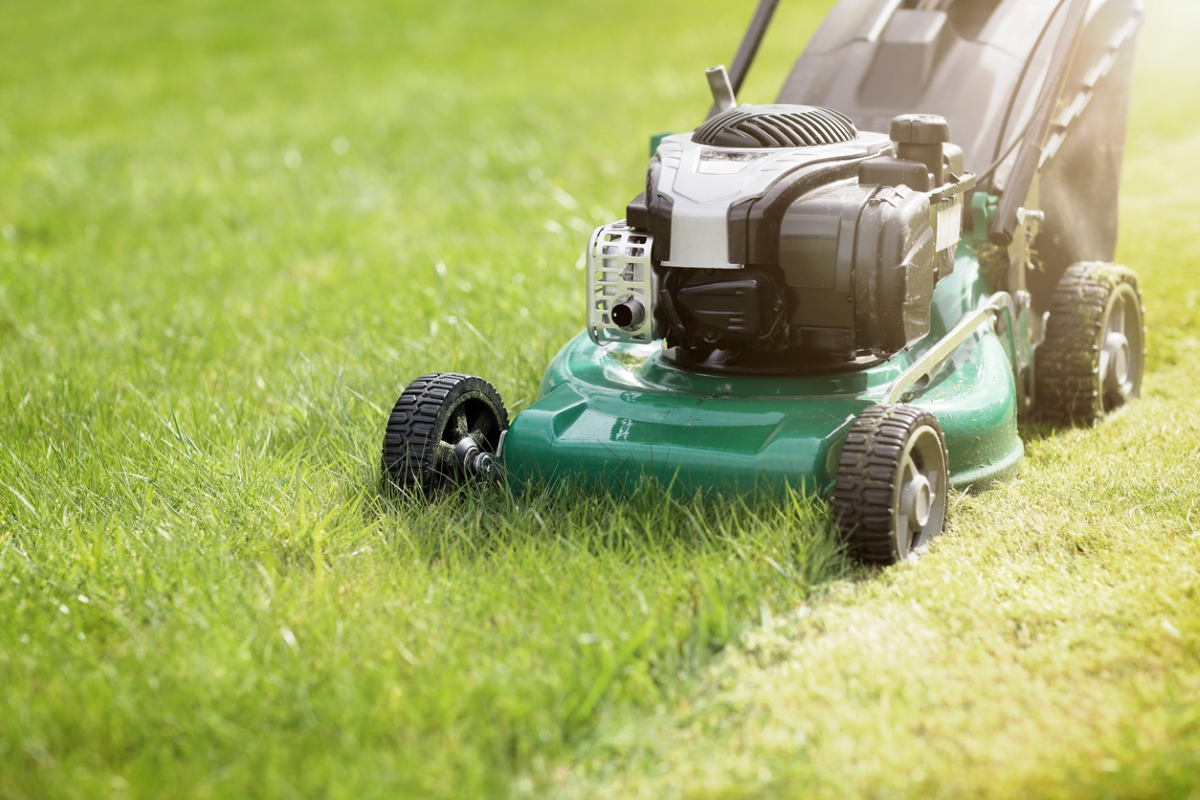

We may earn revenue from the products available on this page and participate in affiliate programs. Learn More ›
I just purchased my first home and it has a gorgeous lawn. I want to make sure I maintain it properly, but I also want to be environmentally friendly. How often should I mow my lawn?
Maintaining the lawn can make or break your home’s curb appeal. Keeping grass green takes planning and effort. Regular watering and seasonal feeding are important, but proper mowing is also crucial for achieving a beautiful lawn. Not only does mowing make the grass look tidy, but it also helps keep it healthy.
Regular mowing is key to a thriving lawn, but the question remains: How often should you mow your lawn? The answer depends on many factors, including the species of grass you have, the season, and the prevailing weather. Mowing too infrequently can leave your lawn looking scruffy, but mowing your lawn too often can have negative consequences for the well-being of your grass. The challenge is finding the happy medium. To figure out how often you should mow your lawn, pay close attention to your grass (its height, its rate of growth, and its overall health) and keep the following guidelines in mind.
How often a lawn needs to be mowed depends on the time of year.
Growing seasons are incredibly important in determining how often you should cut your grass. Different grass species have different ideal growing conditions. Warm-season species, such as Bermuda grass and zoysia grass, do most of their growing in the summer months and are best suited for regions with warm summers and mild winters. The more temperature-durable cool-season species, such as Kentucky bluegrass and perennial ryegrass, grow the most in early spring and fall.
Obviously, grass requires more frequent mowing during its growing season. A rule of thumb for a well-manicured lawn is to mow once a week during the growing season. (If you’ve opted for a grass alternative, such as clover or prairie grass, you’ll need to mow much less frequently.)

Grass height and growth rate should also factor into mowing frequency.
Even during a lawn’s growing season, growth rate can be variable. Pay attention to the height of your grass and the speed at which it’s growing, and adjust your mowing schedule accordingly. For instance, if it hasn’t rained for a while, your grass is probably growing more slowly and may not need to be mowed as frequently. To stay on the right track, remember the one-third rule: Never cut off more than one-third of the length of a blade of grass. So, if you want to keep your grass at 2.5 to 3 inches in height (a typical range for cool-season grasses), you should wait to mow until your lawn is over the 3-inch mark. If you want to grow the lawn out, consider setting the mower blades to a higher level so you’ll be cutting off less of each blade.
Many factors can affect growth rates. Some important ones to keep in mind are rainfall and climate. During times of limited rainfall, you may want to mow the lawn less frequently to ensure that the grass retains the small amount of moisture it is receiving. Cutting back on mowing will help conserve water and keep your lawn healthy.
RELATED: I Let My Lawn Grow for No Mow May—Here’s What Happened
Mowing your lawn too short or too often can stress the grass.
While mowing the lawn is a time-honored suburban ritual, mowing too often or cutting the lawn too short can have negative effects on its health. When grass is too short, it photosynthesizes less effectively, and this affects its access to nutrients. As a result, a too-short lawn directs its energy toward blade growth to improve photosynthesis, leaving less energy for expanding its root system. Cutting the lawn too short or mowing too frequently also inhibits water conservation, and shorter lawns are more prone to weeds.
Longer grass is generally healthier grass. Longer blades mean that less sunlight reaches the soil, preventing weeds from gaining ground. As well, taller grass tends to have longer roots, so it’s better at drawing nutrients from the soil and withstanding drought.
Special care should be taken when mowing after it rains or during a drought.
Avoid mowing the lawn right after it rains. Mowing a wet lawn can be dangerous, and it’s also bad for both the lawn mower and the lawn. First of all, the operator could slip on the wet grass and become injured; if using a corded mower, that person could be at risk of electrocution. The lawn mower itself can be affected by water infiltration, and the wet grass can clog up the mower blades, forcing the motor to work harder. And then there are the consequences for the lawn: Running a lawn mower over wet grass can compact the soil, rip out shallow roots, and leave unsightly ruts. Also, when grass is wet, the mower blades cut unevenly, resulting in a ragged-looking lawn and grass that’s more susceptible to pests and diseases.
If you live in a drought-prone area, keep mowing to a minimum. As mentioned above, taller grass blades provide shade for the roots and soil and help the lawn retain water, which will help cut down on irrigation. In general, it’s a great idea to mow less and set the mower blade height a bit higher than usual during a drought.
Only certain conditions warrant weekly mowing.
Mowing the lawn is a bit more complicated than simply pulling out the lawn mower each Saturday morning. Before you start it up, consider whether your grass is a warm- or cool-season species—in other words, is it in its peak growing period? Also take into account the amount of rain that has fallen recently and the current length of your grass. In general, cool-season grasses should be kept between 2.5 and 3 inches high. If your grass is long enough that you could cut it back by one-third and it will still be in that sweet spot, grab that mower and get to work!
For those who live in places with high rainfall, mowing may be a weekly ritual if the grass typically grows in height by one-third each week. For people living in drought zones, mowing the lawn may be only a monthly chore. You might need to do a little mental gymnastics to come up with your lawn-mowing schedule, but sticking to these tips is helpful.

Waiting too long between each mow can also cause problems.
Waiting too long to cut the grass makes your property look sloppy and can be detrimental to the health of your grass. Overly tall blades hamper air flow, which can lead to fungal diseases, and discourage the formation of new shoots, which makes the lawn thinner. Because cutting tall grass can cause the lawn mower to clog and overheat, it can also increase wear and tear on the lawn mower itself.
If you’ve let your lawn get too long, cutting it drastically in one fell swoop can send the grass into shock, which makes it more susceptible to disease and pests. Instead, cut it gradually over several mowings until you reach the desired height.
RELATED: Solved! The Great Debate on What to Do with Grass Clippings
Final Thoughts
Lawns and landscaping are a vital part of curb appeal. But maintaining a lush, green lawn takes know-how and effort—including regular mowing. To devise a mowing schedule, it is important to consider the grass species you have, the climate in your area, the prevailing weather, and the general health of your lawn.
Mowing too frequently or mowing the lawn too short can result in bad outcomes, including diseased grass, weed growth, poor conservation of water, yellowing grass, and weakened root systems. While there is no perfect frequency for mowing the lawn, studying your lawn and sticking to the one-third rule—making sure that you’re cutting off no more than one-third of the blades’ height—will help keep your lawn looking its greenest!
